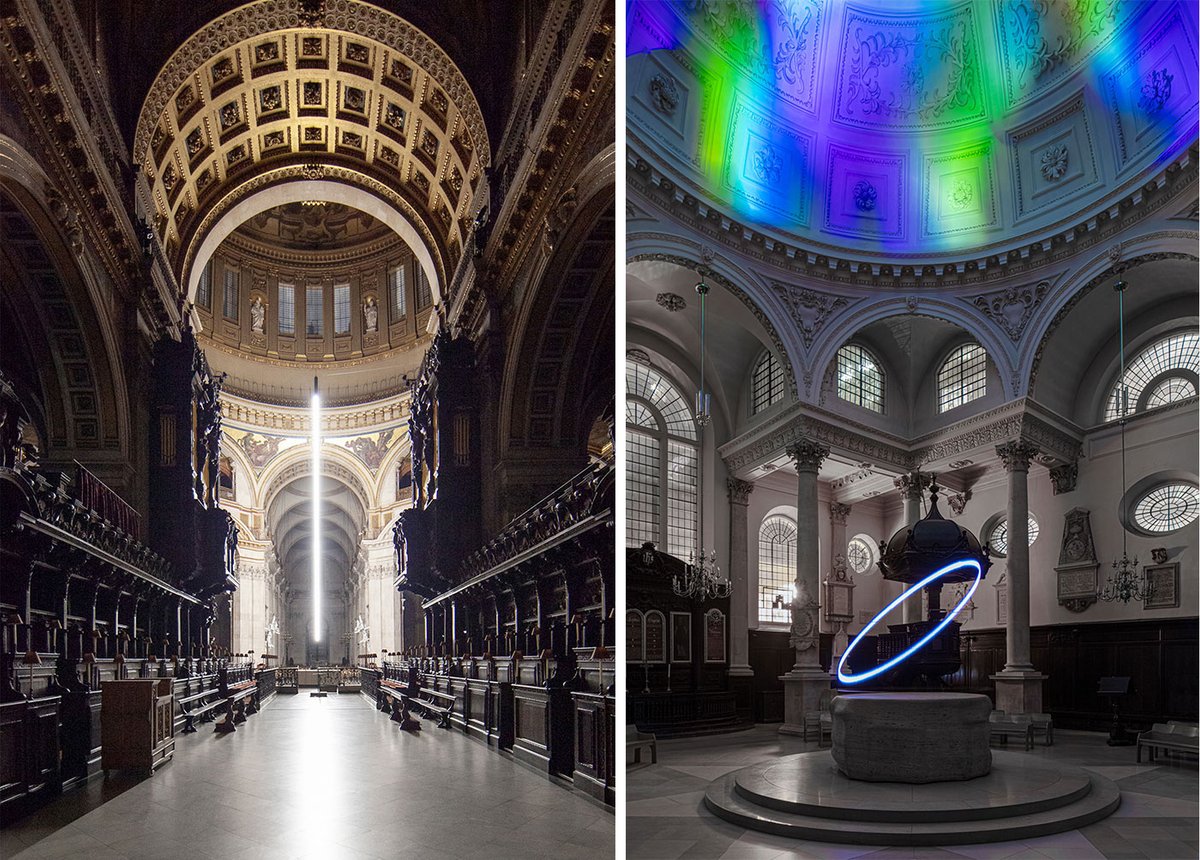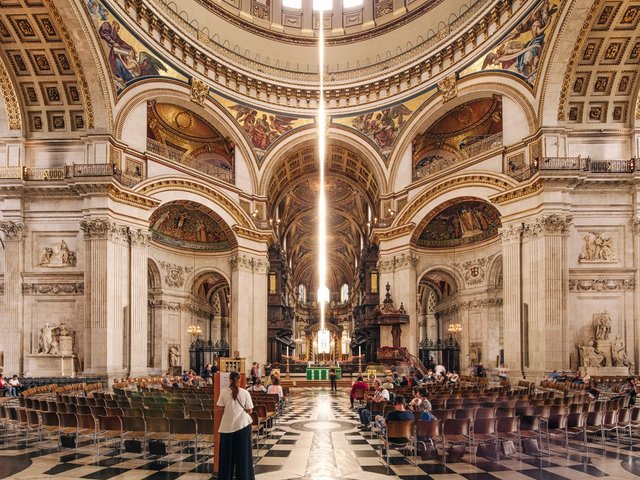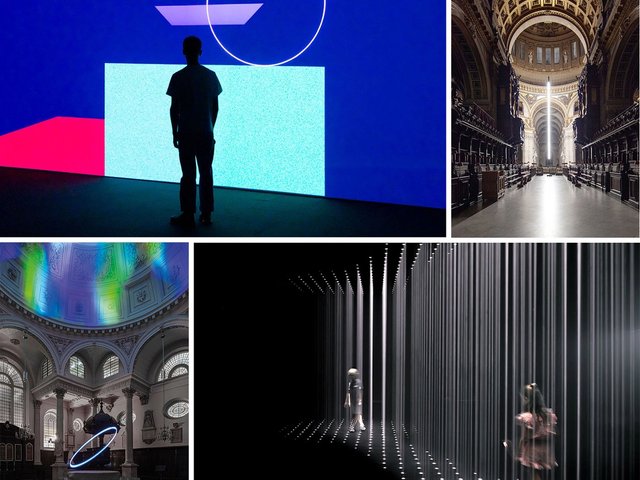To mark the 300th anniversary of the death of Christopher Wren—one of the giants of British architecture, and creator of London landmarks including St Paul's Cathedral and the Royal Hospital Chelsea—the London Design Festival and Bloomberg Philanthropies have commissioned new light installations for two of his finest buildings. Both light pieces were launched with live demonstrations on the eve of the festival's opening on 16 September.
Moritz Waldemeyer, the London-based German artist and designer, devised Halo for St Stephen Walbrook (1672), a City of London church, where the polymath mathematician-architect Wren played intriguingly with the massing of squares and circles to support the first dome in any British building. The church also has a massive circular altar in marble, carved by Henry Moore in 1972, that gives a liturgical centre to the building beneath its 20m-high dome.
Pablo Valbuena, the France-based Spanish installation and light artist, in turn created Aura for the regal St Paul’s, for which Wren wowed King Charles II with an early scheme in the same year that St Stephen's was completed. The cathedral—where Wren the scientist worked out his preoccupations with light and acoustics on a grand scale—was completed in 1710, with its famous dome supported by a lofty, arched nave and transept.
Halo: a pendulum’s conical swing
Waldemeyer’s Halo consists of an 8kg brass weight in the saucer-like form of an elegantly flattened sphere and a 20m cord from which the mass hangs, to create a rotating pendulum attached to the lantern of Wren's dome. The conical swing of the pendulum, sweeping low and slow, just centimetres above the rim of Moore's adamantine altar, has a frequency of 8.4 seconds per circuit, one that generates a constant light (through circuitry fitted in the brass weight) that moves evenly up and down the cord, generated by a sequence of light-emitting diodes (LEDs).
The titular halo is not visible to the naked eye. Waldemeyer, who trained as an engineer, devised the frequency of the pendulum’s swing so that the halo would appear (tilted at an angle because of the mobile light source) in images taken using long-exposure photography whose duration matched the frequency of the pendulum's conical “swing”.
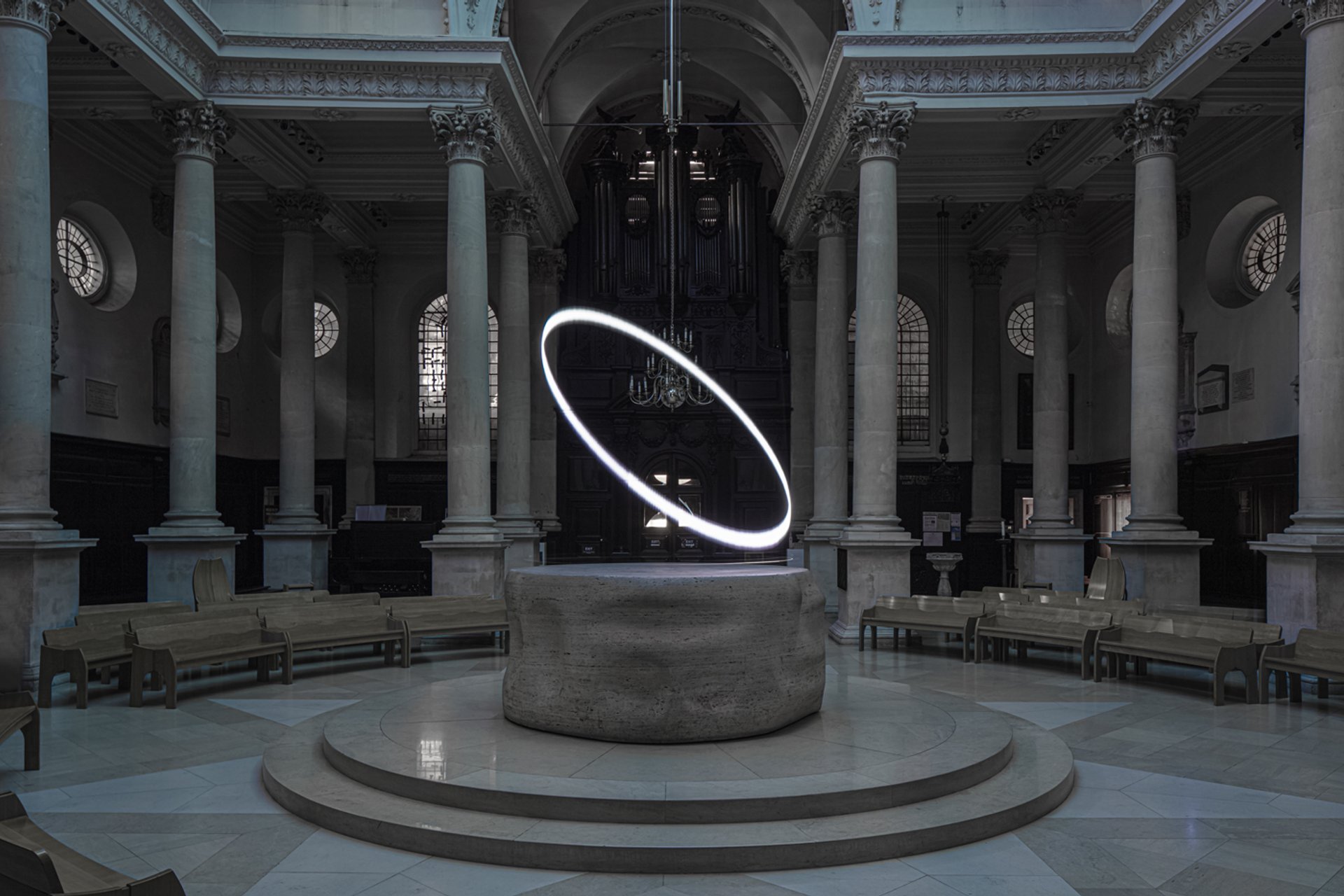
Moritz Waldemeyer's Halo at St Stephen Walbrook, London. The tilted halo form is captured using long-exposure photography to match the 8.4-second frequency with which an illuminated pendulum rotates above the rim of Henry Moore's marble altar London Design Festival. Supported by Bloomberg Philanthropies. Photograph © Ed Reeve
Waldemeyer wants experiencing Halo to be “a meditative moment”, he tells The Art Newspaper. “To look at it and forget about time and space.” To add to the contemplative aspect of his halo-generating pendulum, Waldemeyer projects slowly paced astral patterns onto the coffered dome of St Stephen’s, from projectors placed on the ground floor bases of the pillars that support the dome. He was inspired to make this, drawing on the aurora borealis and the solar flares on the corona of the sun, by Wren's interest in astronomy.
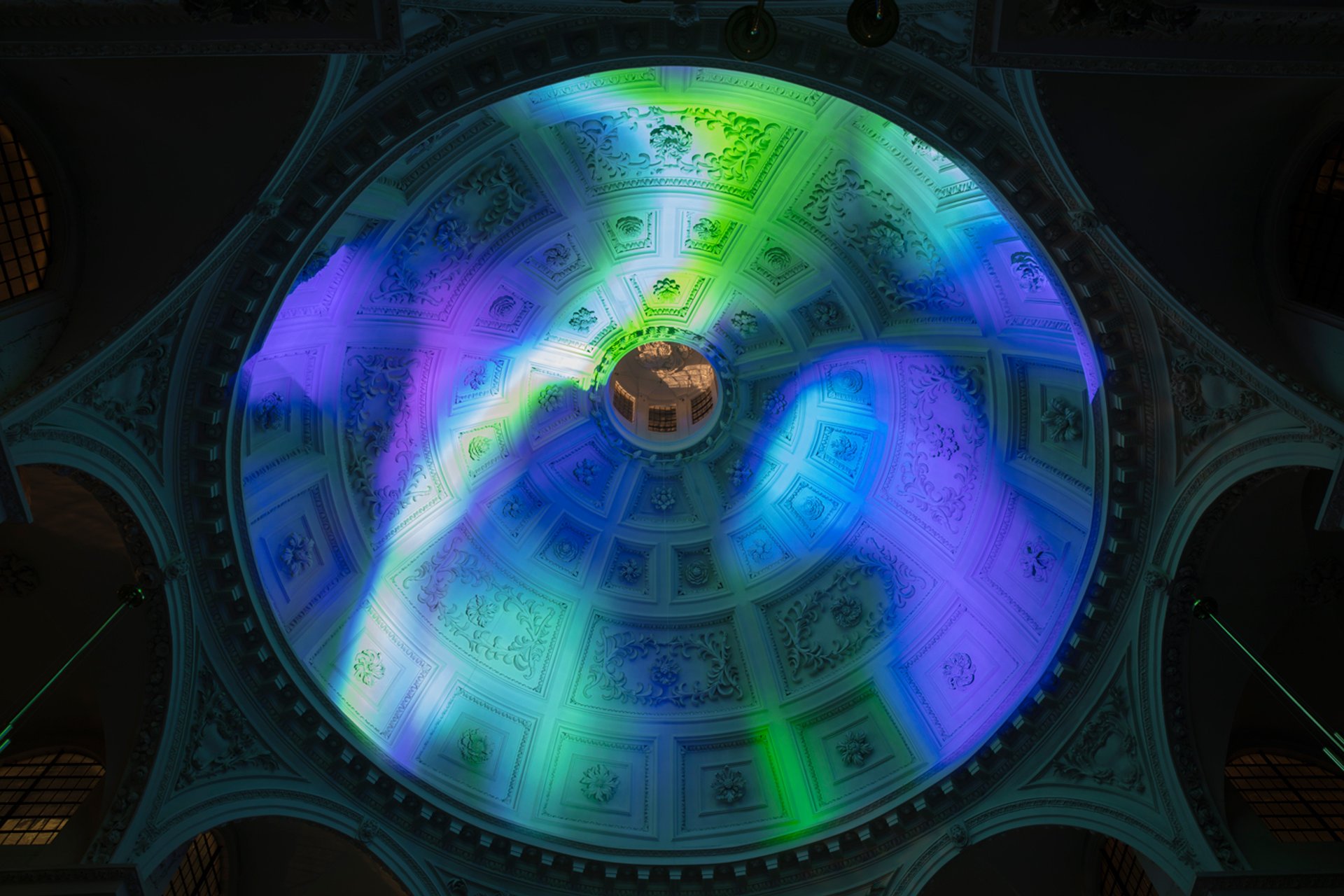
Moritz Waldemeyer's Halo at St Stephen Walbrook, London. The slowly moving projection of astral bodies into the church's dome is designed by Waldemeyer as a tribute to Christopher Wren's interest in astronomy, and as part of Halo's meditative character London Design Festival. Supported by Bloomberg Philanthropies. Photograph © Ed Reeve
He devised both elements of Halo after spending time at the church, and was drawn to the central dome and its height. The 20m ceiling of the dome gave him the height he needed to hang a pendulum, one with a stately, meditative pace of rotation. Through his immersion with the building, Waldemeyer feels he has got to know Wren the polymath scientist, mathematician, philosopher and student of optics. And to admire Wren’s use of daylight to enliven the architecture of his tightly wrought interiors.
For influences, Waldemeyer looks back to Thomas Edison (1847-1931), inventor of the lightbulb, and, more directly, to the late industrial designer Ingo Maurer (1932-2019), who collaborated with Waldemeyer on his redesign of the candle for My New Flame, launched at Maurer's Milan show in 2012, where Waldemeyer used 128 LEDs to recreate the effect of a single flame. Maurer, Waldemeyer says, was "the inventor of the playful take on light design that we now take for granted".
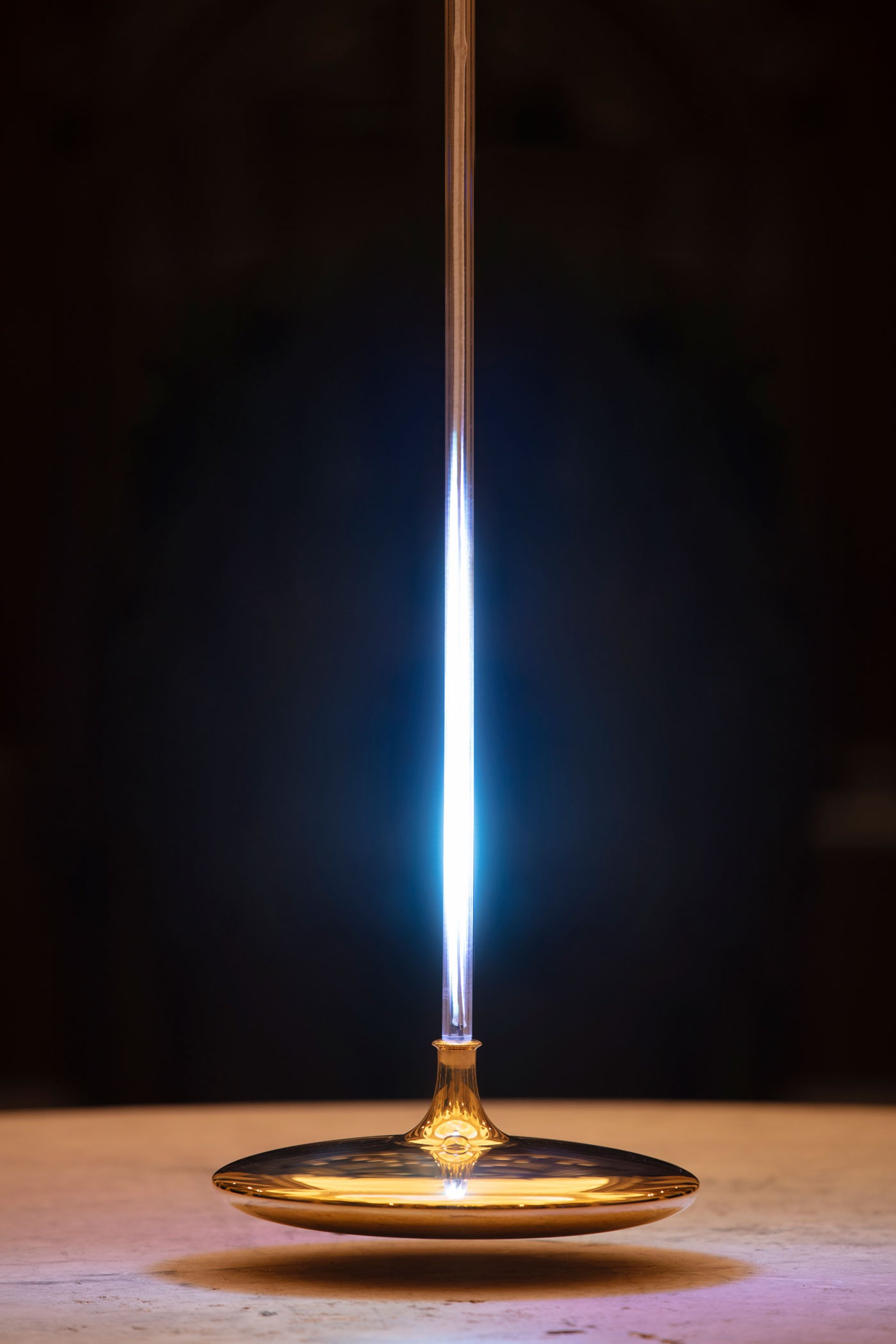
Moritz Waldemeyer's Halo at St Stephen Walbrook, London London Design Festival. Supported by Bloomberg Philanthropies. Photograph: © Ed Reeve
“I started out in the early 2000s,” Waldemeyer says. “The time that LEDs started this incredible journey from being an indicator light on your stereo to be an actual means of illumination.” An LED is an electronic component, one that works well, he explains, with a programmable controller and programming: “[This] gives rise to infinite amounts of creativity... By writing code you can create light effects that weren’t possible previously.” For Halo he used a relatively new LED strip called COB (Chip on Board), “where they put the single LEDs so close together, and encased in a single extrusion, a silicon, so that it looks like neon”.
“Ideas that appeal on an emotional level,” he says. “That is the key combination that draws me down this rabbit hole. To make beautiful things that are emotionally appealing; that use light based on the tech that has developed over the past 20 years.”
Aura: light integrated with sound
For Pablo Valbuena the focus in preparing Aura was to immerse himself in the structure and daily functioning of St Paul’s, and Wren’s thinking behind his masterpiece, for days before considering the nature of the piece he would make. Like Waldemeyer at St Stephen, Valbuena was drawn to the dome, the building’s focus both externally and internally.
Valbuena, who trained in architecture, had previously studied Wren’s approach to the catenary—the shape created by a hanging rope or chain—which, when inverted, forms the ideal profile for a structurally sound dome. (Some of Wren's drawings and calculations for the structural role of the central section of his triple dome are in the collection of the British Museum.)

Pablo Valbuena's Aura hangs from the oculus at the top of the inner dome of St Paul's Cathedral, in London London Design Festival. Supported by Bloomberg Philanthropies. Photograph: © Ed Reeve
He spent three days getting to understand the building and its rituals: the daily liturgy and the contrasting periods of peak tourist visitor numbers. He found the study of theory—and of Wren’s work on the Sheldonian Theatre, Oxford, where Wren developed many of the principles he deployed later in his London churches—served as a complement to the days spent experiencing the building and its daily ecclesiastical life. “You can know theoretical aspects of [a] building, but I would never make a piece [without visiting the location first],“ he tells The Art Newspaper. “The first thing I demand is to go there and invest time.”
Aura is suspended by a cord from the towering oculus at the centre of the cathedral's inner dome. The light sources, a series of hundreds of custom-made LEDs, are hung on a pencil-thin aluminium frame, 20m tall.
“For me, the use of tech is interesting,” Valbuena says. “Am I allowed to speak from a more contemporary mode to questions that have been asked throughout human history? [But I am] not interested in the gadgets, or the newness or the wow factor of a new technology.”
“I try to use the most straightforward, the simplest way to do it with the available technology,” he says. “We do strange things. We have to devise our own custom software, our own custom lights. But it doesn’t mean that it is [technologically] cutting edge.” Valbuena worked on Aura with Artichoke, the arts production company specialising in public art, and with local rigging and sound companies. His team included two technical directors, one focusing on design, electronics and hardware, and another devoted to the technical installation.
“We designed something very light, very material,” Valbuena says. The whole 20m structure weighs 100kg. ”In most of my projects I am interested in [working] with a little amount of matter, [little] weight. If you think about [Richard] Serra or Moore, the sculptures are massive. I am interested in working in a way that is rooted in the virtual, but applying [it] to physical spaces. How, with as little matter [as possible], you can transform [a space].”

Pablo Valbuena's Aura seen from the nave of St Paul's Cathedral, with the backdrop of the choir's windows and ceiling London Design Festival. Supported by Bloomberg Philanthropies. Photograph: © Ed Reeve
The light piece in Aura is activated by sound, using an algorithm devised from scratch by Valbuena's team. The audio is captured by the cathedral’s own microphones, which pick up the spoken words, while additional devices were used to capture the singing of the choir or placed in the organ pipes to catch the complex, reverberant, notes of that mighty instrument.
As the sound varies in pitch, volume and intensity, so the patterns of light generated by Aura change. The higher the pitch the higher the light glows on the work’s frame. The greater the volume or intensity, the brighter and denser the light that Aura emits.
In the first public demonstration of Aura, William Fox, the acting organist and assistant director of music at St Paul’s, played three pieces, starting with J.S. Bach’s Prelude in E Minor. The separation of the light patterns proved satisfactorily mathematical and wide-ranging, with the light patterns matching the broad chord structure, and the even-tempered work of this most mathematical of composers. Aura rippled with broad brilliant explosions of light as the bass drone pipe cut in. In later pieces, the piece glowed expansively and brightly as the organist called on multiple registers at once.
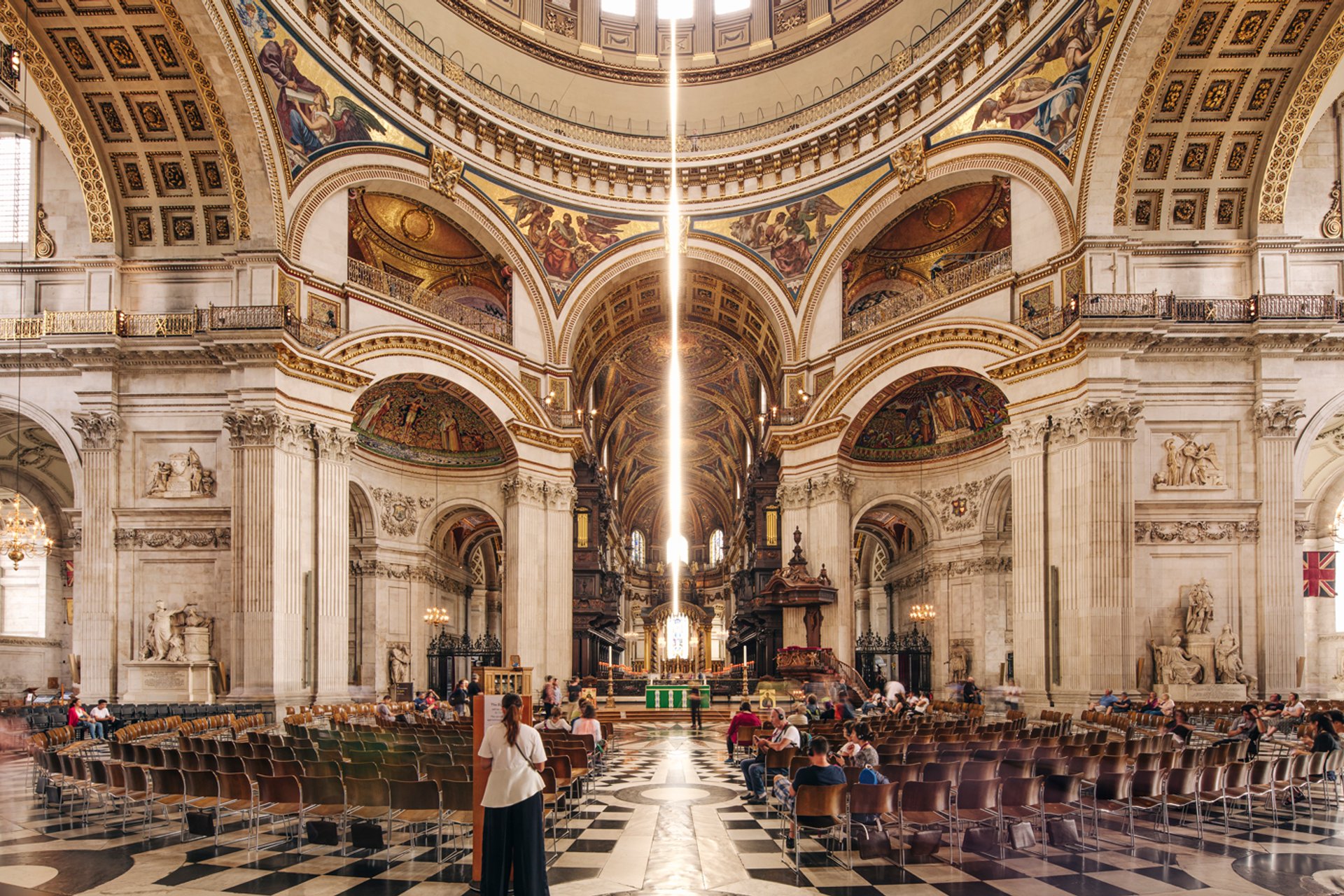
Pablo Valbuena's 20-metre long Aura, which hangs almost down to the floor of transept, seen from the nave of St Paul's Cathedral London Design Festival. Supported by Bloomberg Philanthropies. Photograph: © Ed Reeve
Valbuena had met his desire to create a piece that interacts closely with the cathedral, its liturgical process, and the intellect and spirit of its creator. During the London Design Festival, visitors will get the best chance of sensing that quality of interaction, he says, without charge, at the cathedral’s Evensong, at 5pm daily.
- London Design Festival, until 24 September, various locations throughout London


